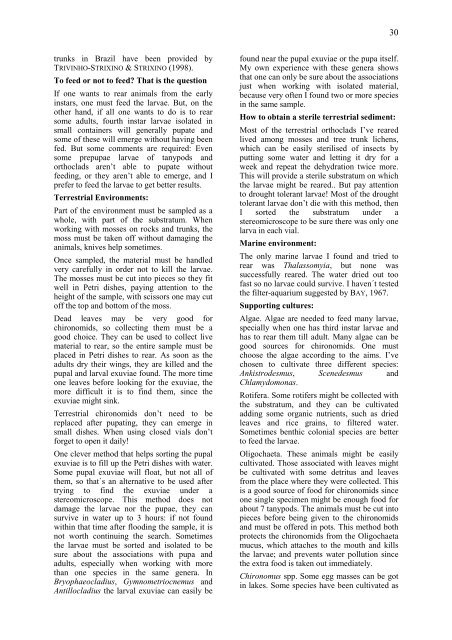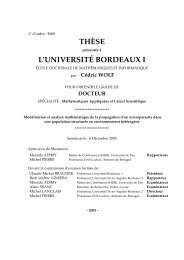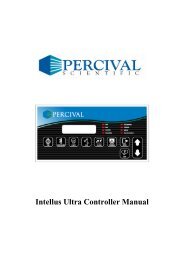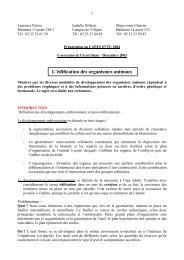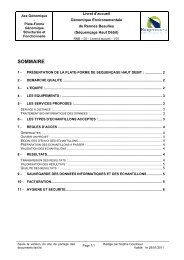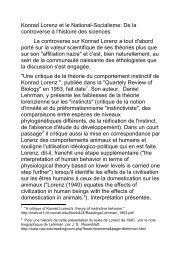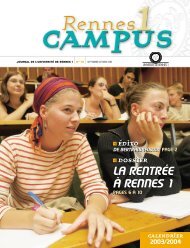1 CHIRONOMUS NEWSLETTER ON CHIRONOMIDAE RESEARCH ...
1 CHIRONOMUS NEWSLETTER ON CHIRONOMIDAE RESEARCH ...
1 CHIRONOMUS NEWSLETTER ON CHIRONOMIDAE RESEARCH ...
Create successful ePaper yourself
Turn your PDF publications into a flip-book with our unique Google optimized e-Paper software.
trunks in Brazil have been provided by<br />
TRIVINHO-STRIXINO & STRIXINO (1998).<br />
To feed or not to feed? That is the question<br />
If one wants to rear animals from the early<br />
instars, one must feed the larvae. But, on the<br />
other hand, if all one wants to do is to rear<br />
some adults, fourth instar larvae isolated in<br />
small containers will generally pupate and<br />
some of these will emerge without having been<br />
fed. But some comments are required: Even<br />
some prepupae larvae of tanypods and<br />
orthoclads aren’t able to pupate without<br />
feeding, or they aren’t able to emerge, and I<br />
prefer to feed the larvae to get better results.<br />
Terrestrial Environments:<br />
Part of the environment must be sampled as a<br />
whole, with part of the substratum. When<br />
working with mosses on rocks and trunks, the<br />
moss must be taken off without damaging the<br />
animals, knives help sometimes.<br />
Once sampled, the material must be handled<br />
very carefully in order not to kill the larvae.<br />
The mosses must be cut into pieces so they fit<br />
well in Petri dishes, paying attention to the<br />
height of the sample, with scissors one may cut<br />
off the top and bottom of the moss.<br />
Dead leaves may be very good for<br />
chironomids, so collecting them must be a<br />
good choice. They can be used to collect live<br />
material to rear, so the entire sample must be<br />
placed in Petri dishes to rear. As soon as the<br />
adults dry their wings, they are killed and the<br />
pupal and larval exuviae found. The more time<br />
one leaves before looking for the exuviae, the<br />
more difficult it is to find them, since the<br />
exuviae might sink.<br />
Terrestrial chironomids don’t need to be<br />
replaced after pupating, they can emerge in<br />
small dishes. When using closed vials don’t<br />
forget to open it daily!<br />
One clever method that helps sorting the pupal<br />
exuviae is to fill up the Petri dishes with water.<br />
Some pupal exuviae will float, but not all of<br />
them, so that`s an alternative to be used after<br />
trying to find the exuviae under a<br />
stereomicroscope. This method does not<br />
damage the larvae nor the pupae, they can<br />
survive in water up to 3 hours: if not found<br />
within that time after flooding the sample, it is<br />
not worth continuing the search. Sometimes<br />
the larvae must be sorted and isolated to be<br />
sure about the associations with pupa and<br />
adults, especially when working with more<br />
than one species in the same genera. In<br />
Bryophaeocladius, Gymnometriocnemus and<br />
Antillocladius the larval exuviae can easily be<br />
30<br />
found near the pupal exuviae or the pupa itself.<br />
My own experience with these genera shows<br />
that one can only be sure about the associations<br />
just when working with isolated material,<br />
because very often I found two or more species<br />
in the same sample.<br />
How to obtain a sterile terrestrial sediment:<br />
Most of the terrestrial orthoclads I’ve reared<br />
lived among mosses and tree trunk lichens,<br />
which can be easily sterilised of insects by<br />
putting some water and letting it dry for a<br />
week and repeat the dehydration twice more.<br />
This will provide a sterile substratum on which<br />
the larvae might be reared.. But pay attention<br />
to drought tolerant larvae! Most of the drought<br />
tolerant larvae don’t die with this method, then<br />
I sorted the substratum under a<br />
stereomicroscope to be sure there was only one<br />
larva in each vial.<br />
Marine environment:<br />
The only marine larvae I found and tried to<br />
rear was Thalassomyia, but none was<br />
successfully reared. The water dried out too<br />
fast so no larvae could survive. I haven´t tested<br />
the filter-aquarium suggested by BAY, 1967.<br />
Supporting cultures:<br />
Algae. Algae are needed to feed many larvae,<br />
specially when one has third instar larvae and<br />
has to rear them till adult. Many algae can be<br />
good sources for chironomids. One must<br />
choose the algae according to the aims. I’ve<br />
chosen to cultivate three different species:<br />
Ankistrodesmus, Scenedesmus and<br />
Chlamydomonas.<br />
Rotifera. Some rotifers might be collected with<br />
the substratum, and they can be cultivated<br />
adding some organic nutrients, such as dried<br />
leaves and rice grains, to filtered water.<br />
Sometimes benthic colonial species are better<br />
to feed the larvae.<br />
Oligochaeta. These animals might be easily<br />
cultivated. Those associated with leaves might<br />
be cultivated with some detritus and leaves<br />
from the place where they were collected. This<br />
is a good source of food for chironomids since<br />
one single specimen might be enough food for<br />
about 7 tanypods. The animals must be cut into<br />
pieces before being given to the chironomids<br />
and must be offered in pots. This method both<br />
protects the chironomids from the Oligochaeta<br />
mucus, which attaches to the mouth and kills<br />
the larvae; and prevents water pollution since<br />
the extra food is taken out immediately.<br />
Chironomus spp. Some egg masses can be got<br />
in lakes. Some species have been cultivated as


